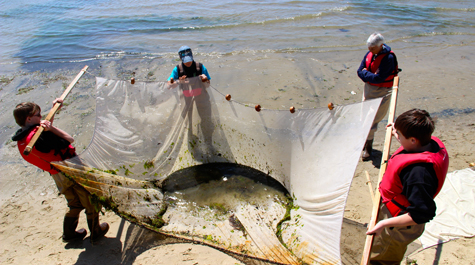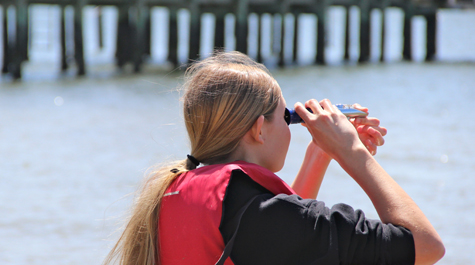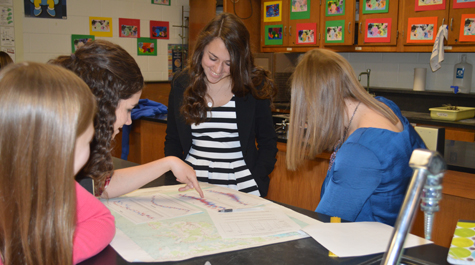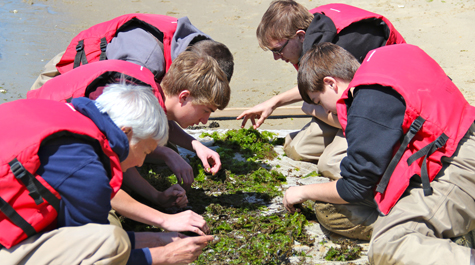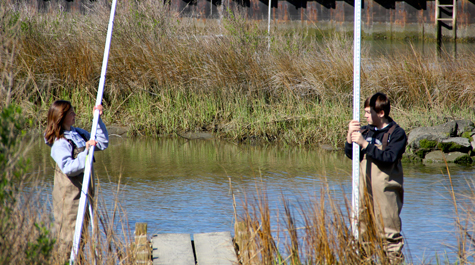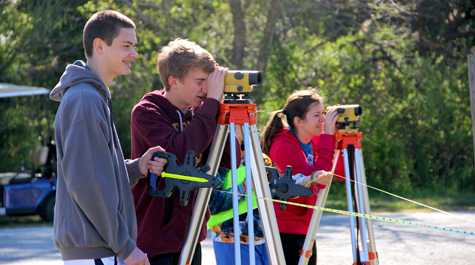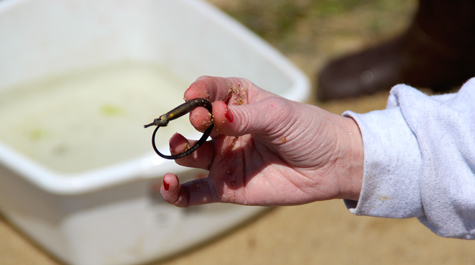Local 9th graders serve as pilot group for new program at VIMS
Gloucester and Mathews students get a closer look at a changing Bay
Ninth graders enrolled in Earth Science at Gloucester High School had the opportunity to get their feet wet last week during a field experience offered by the Chesapeake Bay National Estuarine Research Reserve in Virginia (CBNERR) at the Virginia Institute of Marine Science.
The field experience was the last of four separate visits from Earth Science classes at Gloucester and Mathews High Schools as a part of a new program entitled Climate Education for a Changing Bay (CECB).
Currently funded for the pilot 2013-2014 school year by a grant from NOAA’s Bay Watershed Education and Training Program (BWET), the program aims to improve climate literacy within local high schools through the use of locally relevant environmental data and information in the classroom curriculum, field experiences, and teacher training.
“Our goal in implementing CECB is to meet the requirement mandated in the Chesapeake 2000 Agreement that all students must have a meaningful Chesapeake Bay watershed experience before they graduate from high school,” says CBNERR Education Specialist Jaclyn Beck
Beck says the program examines broad aspects of climate change, while using locally relevant data to address sea-level rise, water-quality topics, and impacts on coastal communities.
“The long-term social, economic, and environmental impacts on the students as a result of CECB include improved community understanding, increase in stewardship, and reduced human impact on the Bay.
Each of the four classes involved in CECB received one classroom lesson at their school, one field experience on school grounds, and one field experience at VIMS—all of which were designed to align with Virginia Standard of Learning (SOLs) for Earth Science.
Jennifer Haydon, one of the four Earth Science teachers involved in CECB, says her students really enjoyed the hands-on activities provided during the classroom visit, as well as the field experience at VIMS. “My students are already asking me when they can go back,” she laughs.
During their field experience at VIMS, the students put knowledge gained during their schoolyard field experience into action in a more realistic setting.
The students first focused on emergent wetlands by reviewing the many ecosystem services of marshes, and used survey equipment to map the zonation of salt-tolerant plants along transect lines in the VIMS Teaching Marsh. After creating a graph of the marsh profile, students estimated how rising sea level would impact this ecosystem.
The students then focused on underwater grasses and shallow-water ecosystems. They calculated biodiversity in these habitats, collected water-quality data to compare to tolerance limits for species collected while seining, and used archived and real-time data to predict which animals and plants could be impacted by climate change.
Lastly, the students participated in a role-playing scenario in which they represented different stakeholder groups including emergency responders, land planners, and watermen. The field experience wrapped up with the students presenting their different scenarios—from creating an evacuation route for their county and identifying shelters, to establishing new areas for development.
“The CECB program helped educate my class about the resources available in their own backyard,” says Haydon. “The program allowed them to discover how and why these resources are important to our community and our way of life.”
“As a result of CECB, students should better understand the science of climate change and how its effects will impact their lives locally through the natural ecosystem and their coastal community,” says Beck.
In addition to CECB, the BWET grant also funded a training workshop for high-school teachers throughout Hampton Roads. During the three-day workshop—to be held on the VIMS campus in June—educators and scientists from CBNERR, VIMS, NOAA, and VIMS Marine Advisory Services will introduce the teachers to Chesapeake Bay, estuaries, and climate change, with a focus on teaching climate change through the use of the Chesapeake Bay Interpretive Buoy System and the National Estuarine Research Reserve’s data and curriculum.
“Teachers who participate in the workshop will create implementation plans and will be provided with materials necessary to return to the classroom and effectively implement climate-change activities,” says Beck.
With the pilot program coming to an end, CBNERR is waiting to find out if CECB will receive funding for the 2014-2015 school year. If so, the program will incorporate every 9th grader in the Gloucester and Mathews school systems, which will afford CBNERR the opportunity to expand their reach from 70 students to 800.
For more information on CBNERR, visit www.vims.edu/cbnerr.


